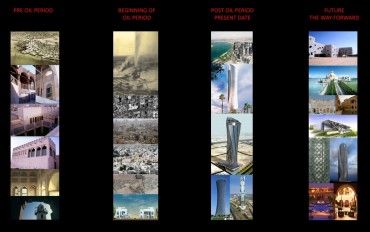Selected Topic
Issue 10 - In the Desert – Natural Conditions: Hotel in the Khor Al-Adaid Desert (July 2012)
Show articles19.12.2012 – Issue 10 - In the Desert – Al Jaidah Ibrahim – Studio, Essays, Videos
Desert Architecture: Some Comments on Qatari Architecture in the Pre- and Post-Oil-Period
Lecture by Ibrahim Al Jaidah
The Gulf’s architectural forms have, to some extent, been limited by two important factors: climate and the availability of building materials. The principal feature of Arabian residential architecture has always been based on the measures taken to protect the inhabitants from the very hot climate of the Gulf’s summer. This feature led to houses being built with thick walls of insulation, with few windows and with devices designed to take advantage of any potentially occurring cooling breeze. Thick, well-insulated walls help minimise heat gain by conduction. Consequently, a common feature of Arabian indigenous architecture is the absence of windows on the exterior walls of a house. Another characteristic of traditional Gulf townscapes was that the buildings tended to be closely clustered together, separated only by narrow shaded alleyways. This meant that buildings offered each other mutual shading, but this may also have been simply a by-product of building clusters for greater security within some defensive perimeters or city walls.
After the discovery of oil, Qatar became a wealthy country and began to embark in the construction industry, which until this day witnesses a large expansion of residential and commercial developments. In this period Qatar saw a transformation of urban development with the introduction of new and Modern urban planning language. This new system of urban planning extended beyond some minor details to embrace a considerable amplification of larger road systems and residential block houses. Consequently, the urban growth of the city of Doha took a completely different shape; in fact one that weakened the old structures and style. Freed of its former status and identity, this upsurge of Modernity during the post-oil period resulted in numberless high-rise glass buildings that for one thing do not reflect the Qatari traditional architecture, and for the other did not respond to the region’s demanding climate.
The heritage of traditional Islamic architecture, including desert architecture, contains various forms, which were developed in response to climate, religious, cultural, and traditional factors along the specificity of the locally built environment. The remarkable traditional settings of medieval cities, the stylish facades of Jeddah’s and Najd’s townhouses, the wind catcher (badgir) of the houses of Dubai’s Bastakia district, or the courtyard houses of Yemen, are all evidence of the richness of Islamic-Arab desert architecture. Every architectural element in the Islamic-Arab house represented a solution or an answer to a different problem that appeared according to a specific condition. In fact, the beauty of these traditional houses represents an art form that has resulted from a peculiar understanding of the unique religious and cultural lifestyle. Thus desert traditional architecture is designed in proportion to its climatic conditions, and more often than not, the epic fabled artistic background of desert cities makes up for the seemingly lack of natural resources and beauty. Keeping out dust, sun and rain are major features to select suitable design features and modern technologies for sustainable buildings. Besides climate, privacy also plays major role to decide upon the selection of materials and degree of openness.
The principles of how Islamic-Arabic cities were built and how buildings were full of architectural intricacies remain active guidelines of our contemporary and future designs. It is relevant that architects in the Gulf region adapt to processes of rapid change, while also valuing the traditional architectural forms; i.e. issues of urban form, of differentiated spaces and their interrelation, of the former construction methods, and forms of utilization, without, however, ignoring the technological and cultural advances of our time. The traditional architecture has, without doubt, its very special charm that provides a strong link to the physical and cultural context it exists in. This architecture has marked an identity both on a private and urban scale, and we should start recognizing its potential before its all gone.
From a lecture given at ETH Zurich, Chair of Prof. Dr. Josep Lluis Mateo
Download article as PDF



